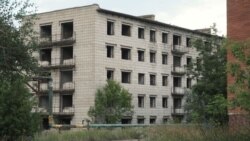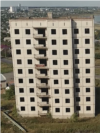Mining stopped here in 1998. Struggling to find alternative work in the area, much of the estimated population of 15,000 drifted away. Today, only a few thousand remain – mostly “[o]ld people,” commented 85-year-old retired miner Petr Petrov, who came to Saumalkol (then called Volodarskoye) during the boom years of the 1980s.
In those days, as for other closed sites connected with the Soviet nuclear industry, working in Saumalkol was a privilege. The jobs came with higher salaries, better consumer services, various discounts, and official respect.
Plus, monitoring of radiation levels. Locals claim that specialists no longer measure radiation in the area. Townspeople blame the radiation for deaths from cancer, but, even so, appear to take the potential risk in stride. Abandoned buildings have been taken apart for construction materials and scrap metal without a second thought.
“We’ve gotten used to radiation,” said Vladimir, a taxi driver. “We don’t know what the level is. No one even bothers with it. The authorities don’t measure it. No one is required to do that.”
In 2018, the North Kazakhstan Oblast Department of Ecology found that radiation from the sealed Grachevskoye mine, close to Saumalkol, exceeded the norm by one and a half times, the department’s deputy director, Azamat Bektasov, told Astana TV. Though the department submitted their findings to local officials, no response came, he alleged.
Based on data from 2018, Kazakhstan, the site of the Soviet Union’s first atomic bomb blast in 1949, ranked as the world’s biggest uranium producer, with 41 percent of the global supply of 53, 498 metric tons, according to the World Nuclear Association, an international nuclear-industry organization.
In those days, as for other closed sites connected with the Soviet nuclear industry, working in Saumalkol was a privilege. The jobs came with higher salaries, better consumer services, various discounts, and official respect.
Plus, monitoring of radiation levels. Locals claim that specialists no longer measure radiation in the area. Townspeople blame the radiation for deaths from cancer, but, even so, appear to take the potential risk in stride. Abandoned buildings have been taken apart for construction materials and scrap metal without a second thought.
“We’ve gotten used to radiation,” said Vladimir, a taxi driver. “We don’t know what the level is. No one even bothers with it. The authorities don’t measure it. No one is required to do that.”
In 2018, the North Kazakhstan Oblast Department of Ecology found that radiation from the sealed Grachevskoye mine, close to Saumalkol, exceeded the norm by one and a half times, the department’s deputy director, Azamat Bektasov, told Astana TV. Though the department submitted their findings to local officials, no response came, he alleged.
Based on data from 2018, Kazakhstan, the site of the Soviet Union’s first atomic bomb blast in 1949, ranked as the world’s biggest uranium producer, with 41 percent of the global supply of 53, 498 metric tons, according to the World Nuclear Association, an international nuclear-industry organization.











